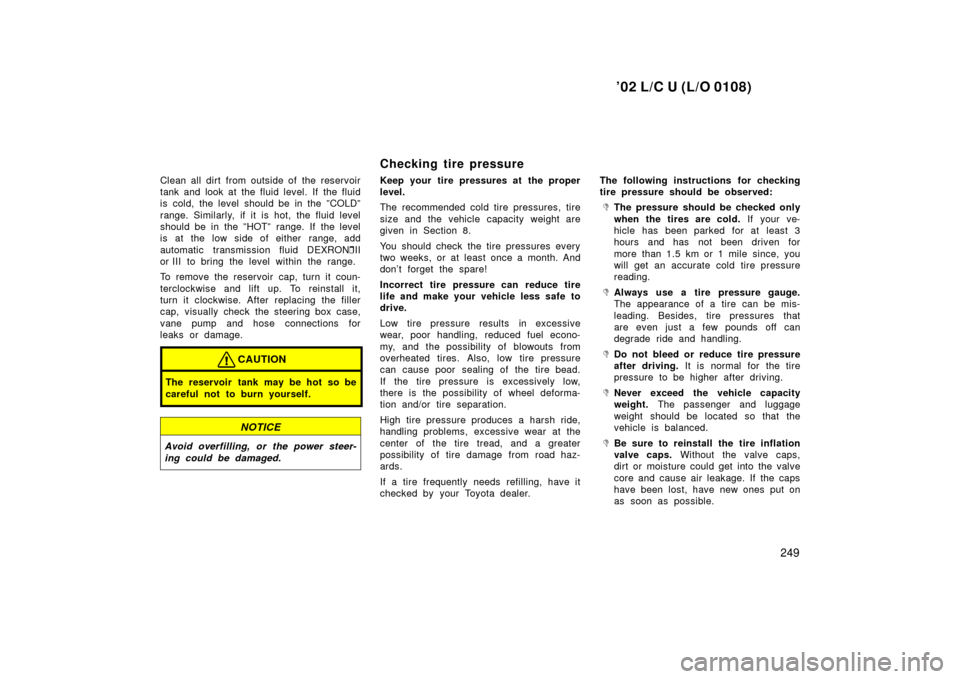Page 250 of 286

’02 L/C U (L/O 0108)
246
Oil identification marks
Either or both API registered marks are
added to some oil containers to help
you select the oil you should use.
The API Service Symbol is located any-
where on the outside of the container.
The top portion of the label shows the oil
quality by API (American Petroleum Insti-
tute) designations such as SL. The center
portion of the label shows the SAE viscos-
ity grade such as SAE 5W�30. ”Energy�
Conserving” shown in the lower portion,
indicates that the oil has fuel�saving ca-
pabilities.
The ILSAC (International Lubricant Stan-
dardization and Approval Committee) Certi-
fication Mark is displayed on the front of
the container.Look at the see�through coolant reser-
voir when the engine is cold. The cool-
ant level is satisfactory if it is between
the ”FULL” and ”LOW” lines on the
reservoir. If the level is low, add ethyl-
ene�glycol type coolant for a proper
corrosion protection of aluminum com-
ponents.
The coolant level in the reservoir will vary
with engine temperature. However, if the
level is on or below the ”LOW” line, add
coolant. Bring the level up to the ”FULL”
line.
Always use ethylene�glycol type coolant
for a proper corrosion protection of alumi-
num components. See information in the
next column.
If the coolant level drops within a short
time after replenishing, there may be a
leak in the system. Visually check the
radiator, hoses, radiator cap and drain
cock and water pump.
If you can find no leak, have your Toyota
dealer test the cap pressure and check
for leaks in the cooling system.CAUTION
To prevent burning yourself, do not
remove the radiator cap when the en-
gine is hot.
Coolant type selection
Use of improper coolants may damage
your engine cooling system. Your coolant
must contain ethylene�glycol type coolant
for a proper corrosion protection of your
engine that contains aluminum
components. Use ”TOYOTA Long Life
Coolant” or equivalent.
In addition to preventing freezing and sub-
sequent damage to the engine, this type
of coolant will prevent corrosion. Further
supplemental inhibitors or additives are
neither needed nor recommended.
Read the coolant container for information
on freeze protection. Follow the manufac-
turer’s directions for how much to mix
with plain water (preferably demineralized
water or distilled water). The total c
apacity
of the cooling system is given in Section
8.
Checking the engine coolant
level
Page 253 of 286

’02 L/C U (L/O 0108)
249
Clean all dirt from outside of the reservoir
tank and look at the fluid level. If the fluid
is cold, the level should be in the ”COLD”
range. Similarly, if it is hot, the fluid level
should be in the ”HOT” range. If the level
is at the low side of either range, add
automatic transmission fluid DEXRON�II
or III to bring the level within the range.
To remove the reservoir cap, turn it coun-
terclockwise and lift up. To reinstall it,
turn it clockwise. After replacing the filler
cap, visually check the steering box case,
vane pump and hose connections for
leaks or damage.
CAUTION
The reservoir tank may be hot so be
careful not to burn yourself.
NOTICE
Avoid overfilling, or the power steer-
ing could be damaged.
Checking tire pressure
Keep your tire pressures at the proper
level.
The recommended cold tire pressures, tire
size and the vehicle capacity weight are
given in Section 8.
You should check the tire pressures every
two weeks, or at least once a month. And
don’t forget the spare!
Incorrect tire pressure can reduce tire
life and make your vehicle less safe to
drive.
Low tire pressure results in excessive
wear, poor handling, reduced fuel econo-
my, and the possibility of blowouts from
overheated tires. Also, low tire pressure
can cause poor sealing of the tire bead.
If the tire pressure is excessively low,
there is the possibility of w heel deforma-
tion and/or tire separation.
High tire pressure produces a harsh ride,
handling problems, excessive wear at the
center of the tire tread, and a greater
possibility of tire damage from road haz-
ards.
If a tire frequently needs ref illing, have it
checked by your Toyota dealer. The following instructions for checking
tire pressure should be observed:
�The pressure should be checked only
when the tires are cold.
If your ve-
hicle has been parked for at least 3
hours and has not been driven for
more than 1.5 km or 1 mile since, you
will get an accurate cold tire pressure
reading.
�Always use a tire pressure gauge.
The appearance of a tire can be mis-
leading. Besides, tire pressures that
are even just a few pounds off can
degrade ride and handling.
�Do not bleed or reduce tire pressure
after driving. It is normal for the tire
pressure to be higher after driving.
�Never exceed the vehicle capacity
weight. The passenger and luggage
weight should be located so that the
vehicle is balanced.
�Be sure to reinstall the tire inflation
valve caps. Without the valve caps,
dirt or moisture could get into the valve
core and cause air leakage. If the caps
have been lost, have new ones put on
as soon as possible.
Page 272 of 286
’02 L/C U (L/O 0108)
268
Dimensions and weight
Overall length mm (in.) 4890 (192.5)
Overall width mm (in.) 1940 (76.4)
Overall height mm (in.) 1875 (73.8)
∗1
Wheelbase mm (in.) 2850 (112.2)
Front tread mm (in.) 1620 (63.8)
Rear tread mm (in.) 1615 (63.6)
Vehicle capacity weight
(occupants + luggage)
kg (lb.) 590 (1300)
562 (1240)
∗2
∗ 1
: Unladen vehicle∗2: With third seats
Engine
Model:
2UZ�FE
Type: 8 cylinder V type, 4 cycle, gasoline
Bore and stroke, mm (in.): 94.0 � 84.0 (3.70 � 3.30)
Displacement, cm
3 (cu. in.):
4664 (284.6)
Fuel
Fuel type: Unleaded gasoline, Octane Rating 87
(Research Octane Number 91) or higher.
For improved vehicle performance, the
use of premium unleaded gasoline with
an Octane Rating of 91 (Research Oc-
tane Number 96) or higher is recom-
mended.
Fuel tank capacity, L (gal., Imp. gal.): 96 (25.4, 21.1)
Page 283 of 286

’02 L/C U (L/O 0108)
v
Publication No. OM60945U
Part No. 01999-60945
Printed in Japan 01−0108 −00
(U)
Quick index
� If a service reminder indicator or warning buzzer comes on cxlix . . .
� If your vehicle will not start ccxcii . . . . . . . . . . . . . . . . . . . . . . . . . . . . . . . . .
� If your engine stalls while driving ccxcvii . . . . . . . . . . . . . . . . . . . . . . . . . . .
� If your vehicle overheats ccxcviii
. . . . . . . . . . . . . . . . . . . . . . . . . . . . . . . . . .
� If you have a flat tire ccc . . . . . . . . . . . . . . . . . . . . . . . . . . . . . . . . . . . . .\
. . . .
� If your vehicle needs to be towed cccxiii
. . . . . . . . . . . . . . . . . . . . . . . . . .
� Tips for driving during break-in period ccxlvii . . . . . . . . . . . . . . . . . . . . . . .
� How to start the engine cclxx . . . . . . . . . . . . . . . . . . . . . . . . . . . . . . . . . . . . .\
� General maintenance cccxxxiii
. . . . . . . . . . . . . . . . . . . . . . . . . . . . . . . . . . . . .\
� Complete index NO TAG . . . . . . . . . . . . . . . . . . . . . . . . . . . . . . . . . . . . .\
. . . . .
Gas station information
Fuel type:
UNLEADED gasoline, Octane Rating 87 (Research Octane Number 91)
or higher. For improved vehicle performance, the use of premium unleaded
gasoline with an Octane Rating of 91 (Research Octane Number 96) or
higher is recommended.
See page ccxlvii for detailed information.
Fuel tank capacity: 96 L (25.4 gal., 21.1 lmp. gal.)
Engine oil:
API grade SJ “Energy −Conserving”, SL “Energy −Conserving” or ILSAC
multigrade engine oil is recommended.
See page cccxlix for detailed information.
Automatic transmission fluid: Automatic transmission fluid D −II or DEXRON
�III (DEXRON�II)
Tire information: See pages ccclv through ccclxii.
Tire pressure: See page ccclxxxv.
U�7
I